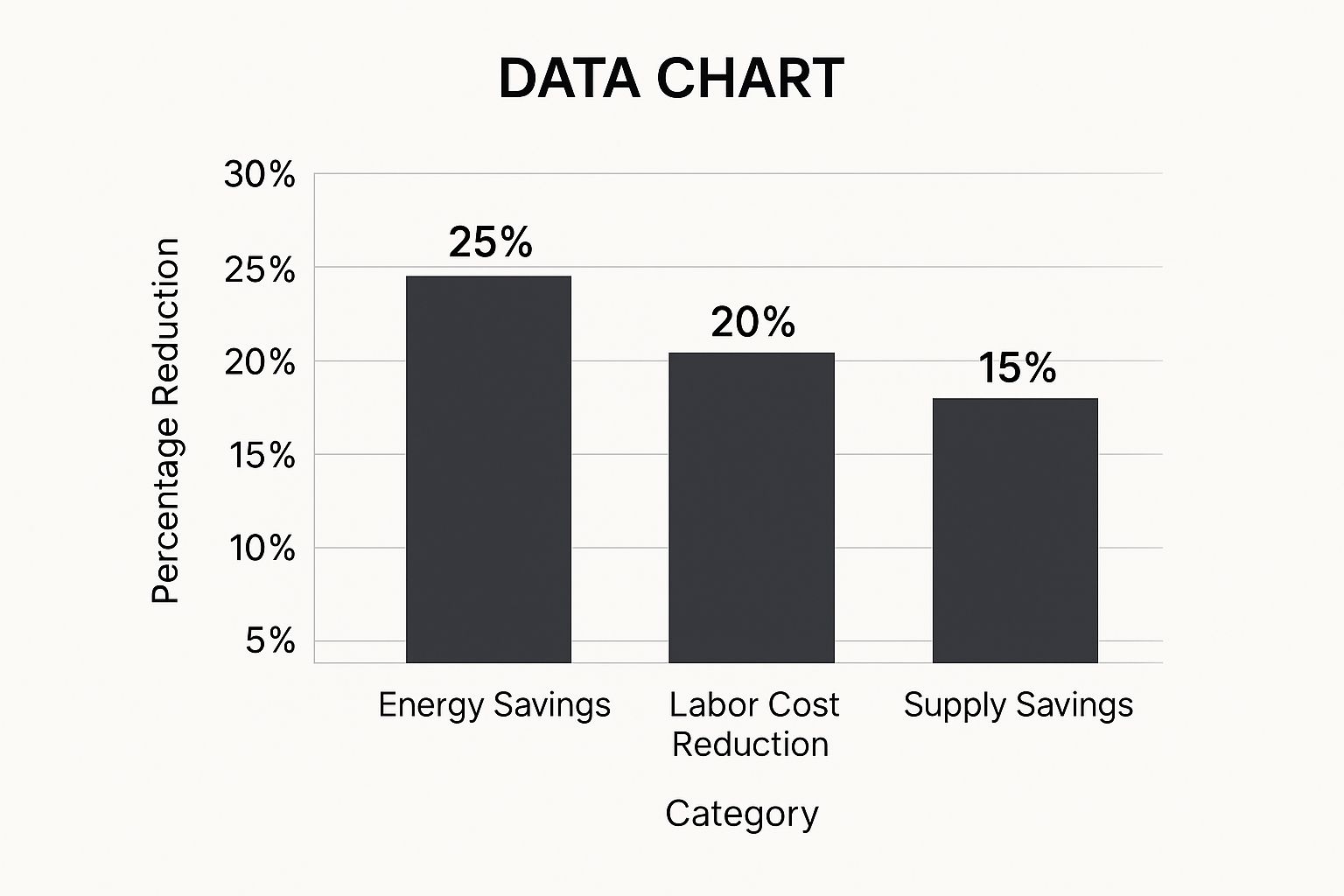Cutting operational costs isn't just about slashing budgets. It's about finding and fixing the financial leaks in your business, big and small. The whole process kicks off with a hard look at every single expense—from your biggest supply chain contracts down to that software subscription you forgot you had. This gives you a clear picture of where to start making smart, effective changes.
Establishing Your Cost Reduction Starting Point
Before you can make any meaningful cuts, you have to know exactly where your money is going. It's easy to get fixated on the big-ticket items like payroll or materials, but I've seen countless businesses get drained by the cumulative effect of smaller, recurring costs. A full audit isn't just about accounting; it's about gaining the clarity you need to make surgical cuts, not just swing an axe.
Think of this initial analysis as your financial baseline—a map that shows every dollar leaving your business. You have to dig deeper than the top-level reports. For instance, a restaurant owner might obsess over food costs but completely miss the fact that their walk-in freezer is an ancient, energy-guzzling monster costing them a fortune in electricity. Or an office might be paying for a premium software package when only two people ever use its advanced features.

Categorizing Your Expenses For Clarity
The best way to start is by grouping your expenses. This simple step makes it much easier to spot patterns and pinpoint areas that are ripe for improvement.
- Direct Costs: These are the expenses tied directly to producing your product or service. Think raw materials, parts, and the labor that goes into assembly.
- Indirect Costs (Overhead): This is all the stuff that keeps the lights on but isn't part of the final product—rent, utilities, marketing budgets, and admin salaries.
- "Hidden" Costs: This is where the real detective work pays off. I'm talking about unused software licenses, duplicate cloud storage accounts, and sneaky bank fees that add up over time.
For anyone running an e-commerce store, a great place to start is figuring out the best ways to reduce Amazon seller fees, as those can quietly eat away at your profits.
A detailed audit isn't just a financial exercise; it's a strategic tool. It turns abstract data into an actionable roadmap, showing you exactly where to focus your efforts for the greatest immediate return.
Once everything is categorized, it’s time to prioritize. You're looking for the low-hanging fruit—the areas where you can see the biggest and fastest savings. Shaving just 10% off a major, inefficient expense will almost always have a bigger impact than eliminating a handful of tiny costs.
Nailing this audit phase sets the foundation for every other cost-saving measure you'll take. It's the essential first move on the path to learning https://clouddle.com/blog/how-to-improve-operational-efficiency/ across your entire operation.
Streamlining Workflows to Eliminate Hidden Waste
Once you've audited your expenses, the real detective work begins. You need to look at how work actually gets done day-to-day. In my experience, inefficient processes are the single biggest source of hidden waste, quietly bleeding money, time, and team morale.
Think about it. We’ve all seen that clunky approval process for a simple purchase order that needs five different signatures. Each one of those sign-offs is a potential bottleneck, a place where progress grinds to a halt.
To find these hidden problems, you have to make them visible. The best way to do that is to map out your core workflows. You don't need fancy software—a whiteboard and some sticky notes work just fine. The goal is to trace a process from start to finish and identify every single touchpoint. When you lay it all out visually, the redundancies and silly extra steps tend to jump right out at you.

I once worked with a marketing team that was spending hours every week manually pulling data from three different analytics platforms just to create a single spreadsheet. When we mapped it out, it became painfully obvious that this repetitive task was a perfect candidate for automation. Freeing them from that drudgery gave them more time for actual strategic analysis.
Identifying and Removing Process Bottlenecks
With your workflow mapped out, you can start trimming the fat using principles from Lean manufacturing. The trick is to question every single step. Ask yourself, "Does this actually add value for the customer or the business?" If the answer is no, it’s probably waste.
Look for these common culprits:
- Waiting: Time spent idling, waiting for an approval, a piece of information, or for someone else to finish their part.
- Over-processing: Doing more work than is actually needed. Think of those hyper-detailed reports that no one ever reads.
- Defects: All the time and resources spent fixing mistakes. It's always cheaper to get it right the first time.
- Unnecessary Motion: Any movement, physical or digital, that doesn't add value. This includes hunting for files across five different disconnected systems.
A clean workflow isn't just about moving faster. It's about creating a smooth, predictable system that reduces errors and frees up your team's brainpower for work that really matters. That’s operational excellence in a nutshell.
To get even deeper insights, you can optimize workflows with AI to boost team productivity, which can often spot inefficiencies that a manual analysis might overlook.
Embracing Automation for Repetitive Tasks
For all those rule-based, repetitive tasks you've uncovered, automation is your best friend. Tools like Robotic Process Automation (RPA) can take over data entry, report generation, and invoice processing without any human input. This isn't about replacing your people; it's about elevating them to more valuable roles.
This philosophy is core to methodologies like Kaizen, which uses technology to ruthlessly eliminate waste. It's not just a theory—major companies are already doing it. In fact, 60% of executives expect to see significant cost savings by aligning their reduction goals with this kind of detailed process analysis. By automating the mundane, they empower their teams to focus on innovation and complex problem-solving.
When you build a culture of continuous improvement—where every team member is encouraged to spot and flag inefficiencies—cost reduction stops being a one-off project. It becomes a sustainable, ongoing part of how you operate.
Using Technology for Smarter Cost Management

Throwing money at the latest tech trend is a surefire way to inflate your budget. The real key to cutting costs is to be surgical with your technology upgrades, targeting the specific areas that are actively draining your resources. Think of these changes less as expenses and more as long-term investments in a leaner, more resilient business.
One of the biggest culprits I see draining budgets is the reliance on physical, on-premise servers. The initial hardware purchase is just the tip of the iceberg. You’re also on the hook for electricity, cooling, security, and the specialized IT staff needed to keep everything running. It’s a constant financial bleed.
Ditching Physical Servers for Cloud Savings
Moving your infrastructure to a cloud platform like Amazon Web Services (AWS), Microsoft Azure, or Google Cloud is often the single most impactful tech change a business can make. It immediately takes expensive server hardware off your books and shifts you to a flexible pay-as-you-go model.
This move doesn't just cut maintenance and energy bills; it gives you incredible scalability. For more on this, check out these cost reduction strategies for modern businesses on onec1.com.
I worked with a growing e-commerce company that was stuck in a cycle of buying new servers every year just to handle the holiday rush. For ten months of the year, that expensive hardware was mostly sitting idle. By migrating to the cloud, they could instantly scale their capacity for November and December, then scale right back down in January. They only ever paid for what they actually used. The result? They cut their infrastructure spending by nearly 60%.
The real power of the cloud isn't just about servers; it's about transforming a massive capital expense (CapEx) into a predictable, manageable operating expense (OpEx). This shift gives you incredible financial flexibility and control.
Smart Upgrades for Equipment and Teamwork
Beyond servers, other tech upgrades can offer surprisingly fast returns. Something as simple as swapping out old hardware for energy-efficient models can make a noticeable dent in your utility bills. This applies to everything from office lighting to the computers and printers your team uses every day.
Here are a couple of other smart swaps to consider:
- Consolidate Your Software: Instead of paying for a dozen different single-purpose apps, look into an all-in-one suite like Microsoft 365 or Google Workspace. You get email, video conferencing, and document collaboration under one, often cheaper, subscription. Plus, having everything in one place makes your team’s life easier.
- Switch to VoIP: If you’re still using traditional phone lines, you’re almost certainly overpaying. Internet-based (VoIP) phone systems are significantly cheaper, especially if you make a lot of long-distance calls. They also come packed with modern features that your old system can't touch.
Each of these shifts is a direct attack on a specific line item in your budget—your power bill, your software subscriptions, your phone bill. By methodically replacing outdated tech with smarter alternatives, you’re not just plugging financial leaks; you’re building a more efficient foundation for years to come.
Using Automation and AI to Drive Down Expenses
Once you've upgraded your core technology, the next logical step is to look at automation and Artificial Intelligence (AI). These aren't just concepts for Fortune 500 companies anymore. Today, AI and automation are accessible tools that can directly target the manual, repetitive tasks that quietly eat away at your bottom line.
Just how much of an impact can they have? Global studies have found that businesses implementing automation and AI have seen their operational costs drop by as much as 30%. By offloading routine tasks in finance, HR, and customer service to automated systems, companies not only save money but also improve efficiency and accuracy. You can find more insights on AI-driven cost savings and see how they're reshaping business strategy.
The easiest place to start is with tasks that are both time-consuming and prone to human error. Think about the hours your team spends on manual data entry, processing invoices, or pulling together weekly reports. Every one of those is a prime target for a simple automated workflow.
Putting Automation to Work in Your Business
Getting started with automation doesn't require a massive, company-wide overhaul. You can begin with small, focused changes that deliver a quick win and build momentum for bigger projects.
Take a small retail business, for instance. Instead of relying on manual inventory counts and gut feelings, they could use an AI-powered system. The software analyzes sales data in real-time, predicts future demand, and automatically reorders products before they run out. This one change solves two huge problems: the cost of carrying too much slow-moving stock and the lost sales from running out of popular items.
Here are a few high-impact areas where you can start:
- Financial Admin: Set up automated invoice processing and payment reminders. You’ll get paid faster and drastically cut down on the manual follow-up required for accounts receivable.
- Customer Support: Deploy an AI chatbot to handle common, repetitive customer questions 24/7. This frees up your human agents to tackle the more complex issues that require a personal touch.
- Human Resources: Automate employee onboarding and payroll. The system can handle the paperwork, schedule orientations, and ensure payroll is accurate and on time, every single time.
Smart automation isn't about replacing people—it’s about making them better at their jobs. It frees your team from soul-crushing, low-value work so they can focus on strategy, innovation, and building customer relationships. You know, the things that actually grow the business.
The following image really brings to life the kind of savings businesses are seeing when they implement these kinds of targeted technology and automation strategies.

As you can see, the numbers are compelling across the board. The reduction in labor costs is often the most significant gain, as all those manual tasks are finally handed off to efficient, automated systems.
A Closer Look at Technology's Impact
When you swap out old methods for new tech, the cost savings become very clear. This table breaks down a few common examples I've seen in the field.
| Impact of Technology on Operational Costs |
|---|
| Business Function |
| Traditional Approach |
| Technology-Driven Solution |
| Primary Cost Saving |
| Customer Service |
| A team of agents answering phones and emails during business hours. |
| An AI-powered chatbot handles 70% of inquiries 24/7; human agents manage complex cases. |
| Reduced labor costs by decreasing the number of agents needed for basic support. |
| Inventory Management |
| Manual stock counts, spreadsheets, and ordering based on historical sales or guesswork. |
| An automated system that tracks sales in real-time, forecasts demand, and reorders automatically. |
| Reduced carrying costs by preventing overstocking and eliminating lost sales from stockouts. |
| Marketing |
| Manual ad campaign management, A/B testing, and audience segmentation. |
| Programmatic advertising platforms that use AI to optimize ad spend and targeting in real-time. |
| Lower Cost Per Acquisition (CPA) and reduced wasted ad spend on underperforming campaigns. |
| Accounts Payable |
| Manually entering invoice data, routing for approval, and cutting physical checks. |
| Optical Character Recognition (OCR) software scans invoices and automated workflows handle approvals and digital payments. |
| Drastically reduced labor hours spent on data entry and processing; elimination of late payment fees. |
The pattern is undeniable: technology not only speeds things up but also directly cuts the fat from your operational budget by reducing manual labor and preventing costly errors.
The Strategic Value of Outsourcing
While you're automating internal processes, it’s also a good time to ask a critical question: does every single business function really need to be handled in-house?
Strategic outsourcing lets you access specialized expertise without the financial burden of a full-time salary, benefits, and training. Functions like IT management, high-level digital marketing, or complex bookkeeping are often handled more efficiently by a dedicated third-party provider. This move turns a fixed salary into a flexible, predictable operational expense, giving you more control over your budget while getting world-class results.
Your supply chain is one of those areas ripe with opportunities for savings, but you have to dig for them. Too often, I see businesses get stuck in a transactional mindset with their vendors, always chasing the absolute lowest price on paper. But the real, sustainable cost reductions come from building smart partnerships and scrutinizing your entire logistics chain.
It all begins with your existing vendor contracts. Don't just let them auto-renew in a filing cabinet somewhere. Get proactive. Schedule regular reviews and walk into those meetings armed with data on your order history and payment consistency. Good, reliable customers are hard to find, and most suppliers will be open to discussing better terms to keep your business.
Renegotiate and Consolidate for Leverage
One of the quickest ways to gain some negotiating muscle is to consolidate your purchasing. If you’re buying the same type of components from three different suppliers, your leverage with each one is diluted. Funnel that spending to a single, high-quality partner, and suddenly you’re a much more valuable client.
This isn't just about shaving a few cents off the per-unit cost. Consolidation opens the door to bigger wins.
- Volume Discounts: This is the most straightforward benefit of placing larger orders.
- Extended Payment Terms: Getting more breathing room on payments can work wonders for your cash flow.
- Lower Shipping Costs: Bundling orders almost always results in more efficient and cheaper freight.
I once worked with a small manufacturing firm that was sourcing its packaging from five different vendors. It was a logistical headache. We helped them consolidate down to two primary partners. The result? They immediately secured a 15% discount on materials and, just as importantly, simplified their entire procurement process, freeing up hours of administrative time each week.
Building True Vendor Partnerships
Think beyond the transaction. Your best suppliers should operate like an extension of your own team. A true partner genuinely cares about your success. When you open up about your business goals and operational hurdles, they can bring fresh ideas to the table—solutions you might never have thought of on your own.
A strong vendor partnership moves beyond price negotiations and into collaborative problem-solving. This is where you unlock long-term value, finding efficiencies in materials, logistics, and even product design that benefit both sides.
For instance, a supplier who understands your end product might suggest a slightly different raw material that's more cost-effective or a new packaging design that cuts down on shipping weight. You just don't get that level of collaboration when you're constantly vendor-hopping. It’s also worth noting that your technology vendors are a key part of this ecosystem; looking into effective IT cost saving strategies can show how those relationships impact your bottom line, too.
Modern supply chain management software gives you the hard data you need to drive these strategic conversations. You get a crystal-clear view of your inventory, which helps you sidestep the expensive mistake of over-ordering materials that just gather dust. This visibility lets you graduate from reactive purchasing to a much smarter, data-backed strategy. When you strengthen every link in the chain, you’re not just saving money—you’re building a more resilient and profitable business.
Your Top Questions About Cutting Costs, Answered
Starting a cost-cutting initiative always sparks a few questions. I get it. You need clear, practical answers to build a plan that actually sticks. Let's tackle some of the most common questions I hear from business leaders when they start looking for ways to tighten the belt.
The idea here is to give you real-world advice you can put to work immediately. From quick wins that pad your bottom line this month to bigger shifts that change your company culture for the better, let's get into the details.
What's the Fastest Way to Reduce Operational Costs?
If you want to see an immediate impact, the first thing to do is a deep dive into all your recurring expenses. This is where you'll find the low-hanging fruit. Go through every single software subscription, utility bill, and vendor contract with a fine-tooth comb.
It's amazing how many businesses are paying for software licenses that nobody uses or for premium-tier services they don't actually need. Simply renegotiating with a key supplier or canceling a few forgotten subscriptions can free up cash right away with almost zero disruption to your team's workflow.
The quickest savings are almost always found by plugging the quiet, automated leaks in your budget. A thorough review of recurring payments can expose significant waste that’s been flying under the radar for months—or even years.
How Can a Small Business Reduce Costs Without Laying Off Employees?
This is a big one. The key is to focus on making your current operations smarter, not smaller. Technology and process improvements are your best friends here. Instead of cutting your team, you're giving them the tools to do more meaningful work.
Here are a few strategies that don't involve tough conversations about headcount:
- Automate the Grunt Work: Use software to take over repetitive tasks like data entry, processing invoices, or pulling standard reports. Your team will thank you.
- Invest in Long-Term Efficiency: Sure, switching to energy-efficient equipment or LED lighting has an upfront cost. But those savings on your utility bills start compounding month after month.
- Rethink Your Tech Stack: For a lot of smaller companies, outsourcing IT is a huge win. You can learn more about how managed IT services are perfect for small businesses and how they cut down on overhead.
- Build a Cost-Aware Culture: Get everyone to think like an owner. When your entire team is looking for small ways to save, the collective impact can be massive.
How Do I Measure the Success of My Cost Reduction Efforts?
You can't just "feel" your way to success here; you need to back it up with cold, hard data. Tracking the right Key Performance Indicators (KPIs) is the only way to know what's working and where you need to adjust your approach.
Before you change a thing, you need to establish a baseline for these key metrics:
- Operating Expense Ratio (OER): This is a simple one. It compares your total operating expenses to your total revenue, giving you a bird's-eye view of your efficiency.
- Cost Per Unit: If you make a product or provide a service, this tells you exactly how much it costs to produce one widget or help one customer. It's a fundamental number to know.
- Return on Investment (ROI): When you spend money on new tech to save money, you have to measure the return. Calculate its ROI by comparing the cost of the tool against the direct savings it creates, like reduced labor hours.
By keeping a close eye on these numbers, you can turn cost-cutting from a one-off project into a sustainable, data-driven part of how you run your business.
Ready to transform your operational efficiency with smart technology? The team at Clouddle Inc specializes in creating integrated IT, security, and cloud solutions that cut costs and drive growth. Discover how our managed services can build a more resilient and profitable future for your business.


